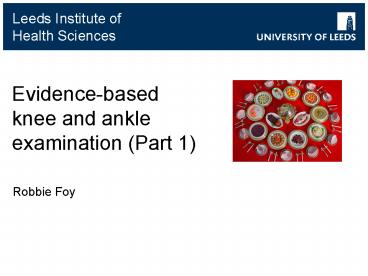Evidence-based knee and ankle examination (Part 1) - PowerPoint PPT Presentation
1 / 24
Title:
Evidence-based knee and ankle examination (Part 1)
Description:
Evidence-based knee and ankle examination (Part 1) Robbie Foy All orthopaedics in review Clinical research, such as the earlier exemplars, continually produces new ... – PowerPoint PPT presentation
Number of Views:108
Avg rating:3.0/5.0
Title: Evidence-based knee and ankle examination (Part 1)
1
Evidence-based knee and ankle examination (Part 1)
- Robbie Foy
2
Evidence based medicine
- the conscientious, explicit, and judicious
use of current best evidence in making decisions
about the care of patients means integrating
individual clinical expertise with the best
available external evidence evidence - Sackett et al. BMJ 199631270-71
3
What do we want out of a diagnosis?
- Greater margin of certainty or safety
- Rationale for clinical management
- Better clinical outcomes
- More efficient use of limited resources
4
Problems with diagnostic tests
- Lack of evidence
- Quality of evidence
- Timeliness of evaluations
- Understanding of concepts and application
- Getting evidence into practice
5
A review of diagnostic test evaluations
- 184 studies evaluating 218 diagnostic tests
- Only 7 of reviewed studies met all quality
criteria - Accuracy of poorer quality evaluations
over-estimated - Accuracy of poorer quality evaluations was
over-estimated (in worst case) by up to three
times - Lijmer et al. JAMA 19992821061-6
6
Back to school
Disease present Disease absent Total
Test positive a b ab
Test negative c d cd
Total ac bd abcd
- Sensitivity the probability of testing positive
if the disease is truly present - Specificity the probability of testing negative
if the disease is truly absent
7
The dummys guide
- SpIN
- High specificity helps rule a diagnosis IN
- SnOUT
- High sensitivity helps rule a diagnosis OUT
8
Fear of the McMurray Test
9
The McMurray Test
- To perform the test, the knee is held by one
hand, which is placed along the joint line, and
flexed to ninety degrees while the foot is held
by the sole with the other hand. The examiner
then places one hand on the lateral side of the
knee to stabilize the joint and provide a valgus
stress. The other hand rotates the leg externally
while extending the knee. If pain or a "click" is
felt, this constitutes a "positive McMurray test"
for a tear in the medial meniscus. Likewise the
medial knee can be stablized and the leg
internally rotated as the leg is extended. A tag,
caused by a tear will cause a palpable or even
audible click on extension of the knee. A
positive test indicates a tear of the lateral
meniscus - Wikipedia
10
(No Transcript)
11
Performance of the McMurray Test
- Sensitivity 53
- Specificity 59
- (Versus gold standard of arthroscopy)
12
Causes of variations in performance
- Patient selection
- Examiner specialty
- Examiner skills and experience
13
The performance of composite examination
- Sensitivity 77
- Specificity 91
14
What do I want out of today?
- To learn the best performing and most efficient
combination of techniques to examine the knee - Including history taking
- Specifically for meniscal injuries?
- To increase my skills and confidence in applying
these techniques
15
The Chinese Banquet Menu Syndrome
16
What do you want out of today?
- Take a minute to write down 2-3 key learning
objectives
17
What do you want out of today?
- Take a minute to write down 2-3 key learning
objectives - Take a minute to compare these with your neighbour
18
What do you want out of today?
- Take a minute to write down 2-3 key learning
objectives - Take a minute to compare these with your
neighbour - Share some examples
19
Evidence-based knee and ankle examination (Part 2)
- Robbie Foy
20
Bad doctors?
- In almost all studies the process of care did
not reach the standards set out in national
guidelines or set by the researchers themselves. - Seddon ME, Marshall MN, Campbell SM, Roland MO.
Qual Health Care 2001, 10152-158.
21
A psychological framework to think through
changing practice
- Behavioural theory offers a basis for
understanding clinical practice and thereby a
rationale for strategies to change behaviour - Consensus process identified main constructs from
33 psychological theories and grouped them into
12 domains - Subsequent semi-structured interview schedule
- Michie S, et al. Qual Saf Health Care
20051426-33
22
A psychological framework to think through
changing practice
Domain Illustrative questions
Knowledge Do you know why you are doing X?
Skills Do you know how to do X?
Professional role Should you be doing X?
Self-efficacy How confident are you about doing X?
Beliefs about consequences What will happen if you do X?
Motivation and goals How much do you want to do X?
Memory and attention Will you remember how to do X?
Environment and context Are there competing tasks and constraints?
Social influences Do your colleagues / patients expect you to do X?
Emotion How do you feel about doing X?
Behavioural regulation What preparatory steps are needed to do X?
Nature of the behaviour What is X?
23
What did you get out of today?
- Were you able to meet your learning objectives?
- Did you change any of your learning objectives?
- Discuss with your neighbour
24
What did you get out of today?
- Were you able to meet your learning objectives?
- Did you change any of your learning objectives?
- Discuss with your neighbour
- How do you plan to put your learning into
practice? - Discuss with neighbour
- Share your suggestions































